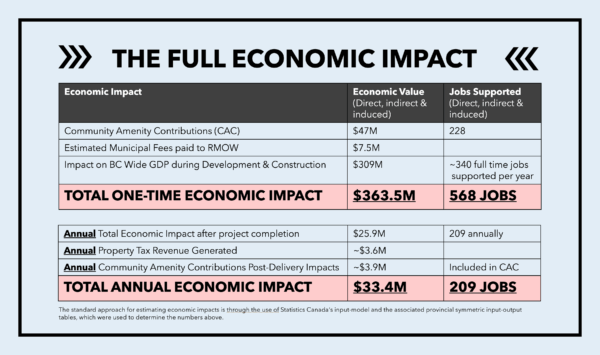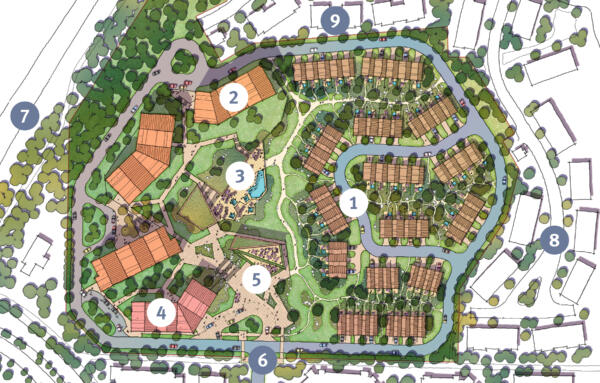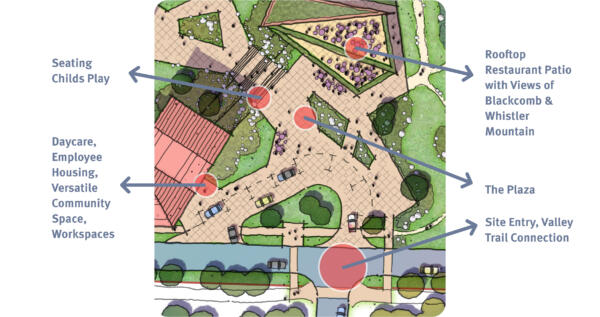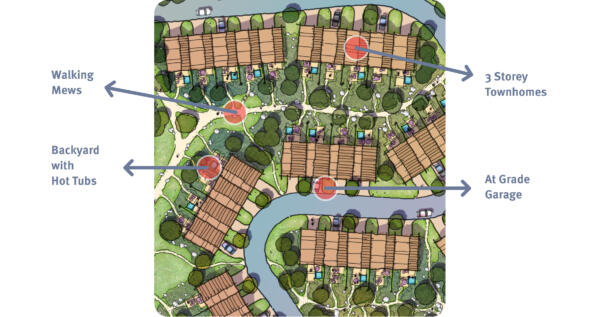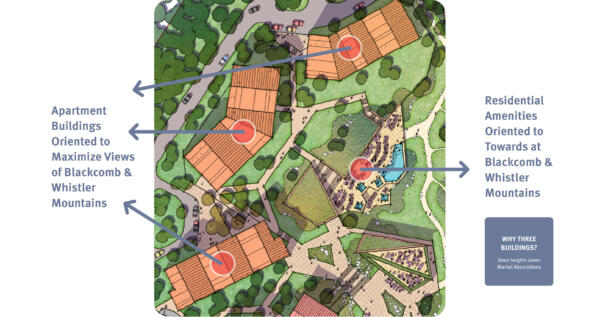2018: Unfortunately, a rezoning application could not proceed until the Official Community Plan of Whistler was adopted.
February 2020: After RMOW hired a new Planning GM, Beedie submitted a Letter of Intent to rezone the property.
September 2020: RMOW began drafting a formal engagement plan.
February 2021: RMOW proposed a draft schedule with three public engagement rounds. Beedie did not agree to the extended timeline but worked with staff to revise and streamline it.
March 2021: Mayor and Council endorsed a three-phase public engagement process for 4500 Northlands.
April 2021 to June 2021: At RMOW’s request, Beedie presented the project to the Strategic Planning, Recreation and Leisure Advisory, Accessibility and Inclusion, and Transit Advisory Committees.
June 1, 2021: RMOW staff presented draft guiding principles and a public engagement plan to Council
June 15 to July 19, 2021: Public Engagement #1 included an online session with 20 breakout rooms and a questionnaire for residents and non-residents.
August 17, 2021: RMOW staff sought Council’s endorsement of the draft guiding principles
November 4, 2021: Beedie submitted a Hotel Community Amenity Contribution (CAC) model based on a hotel analysis study by a HVS Global Hospitality consultant.
November 24, 2021 to May 16, 2022: Beedie and RMOW met to review the hotel study.
July 6, 2022: At RMOW’s request, Beedie was asked to revise the Hotel CAC financial model to reflect a 1999 rezoning proposal by a previous developer. While this conflicted with the hospitality consultant’s recommendations, Beedie adjusted the model to help advance the process.
From September 2021 to February 2022: Beedie submitted a comprehensive package to RMOW, including a topographic survey, geotechnical report, groundwater study, site disclosure statement, amenities channel stream designation, energy strategy concept, and civil servicing concept plans.
June 13 2022: Public Engagement #2 presented two concepts for community input.
July 2022 to February 21, 2023: Beedie awaited feedback from Open House #2 and RMOW direction on refining the site plan.
February 21, 2023: RMOW staff presented feedback from Open House #2 and sought Council approval to proceed with selecting a preferred site plan.
April 6, 2023: Beedie met with new General Manager of Climate Action, Planning and Development Services
June 7, 2023: Beedie met with RMOW staff to review the updated hotel CAC financial model and revised site concepts based on Phase 2 engagement feedback.
June 14, 2023 – July 20, 2023: Beedie met with RMOW staff for a design and site planning workshop.
August 3, 2023: Beedie submits CAC Rezoning (Housing) financial model.
August 31 & September 11, 2023: Beedie resubmitted a revised Hotel CAC model based on the 1999 Park Georgia application, as requested by staff, and met with RMOW staff and RMOW financial consultant Coriolis Consulting Group.
October 11, 2023: Beedie provides RMOW with supplementary CAC data for both the Hotel and Rezoning financial models.
December 22, 2023: To keep the process moving during CAC financial negotiation, Beedie submitted:
- Preliminary Green Building Policy Checklist
- 25% Geometric Civil Design (Off-site)
- Northlands & Lorimer Intersection Analysis
- A revised in-progress Architectural Form package
December 27, 2023: RMOW provides a comprehensive response to Beedie’s CAC financial models submitted on July 20 and August 3, 2023.
January 17, 2024: Beedie submits a formal response to RMOW’s feedback on the CAC financial models.
February 2, 2024: Beedie met with RMOW staff to review the Green Building Policy Checklist, 25% Offsite Design, and Intersection Analysis.
February 6, 2024: Beedie and RMOW staff met to review and discuss the CAC financial models.
February 7, 2024 to May 30, 2024: Beedie and RMOW met to finalize CAC negotiations. Beedie continued to disagree with the use of outdated 1999 assumptions in the hotel financial model, including a $1.25 employee housing rate and Phase 1 limits within the hotel, but accepted them as placeholders to keep the process moving.
July 12, 2024: RMOW’s CAC analysis set the value at $57.8 million, based on 75% of full value using peak 2022-2023 Whistler residential market conditions. While Beedie accepted these assumptions at the time of submission, market conditions have since declined, and a reassessment is warranted.
September 26, 2024: At RMOW’s request, Beedie shared data showing a market slowdown since the 2022–2023 peak, supporting a reduction to the CAC based on current conditions.
September 26, 2024: Beedie submits CAC Letter #1 to RMOW, proposing a $46 million contribution, with allocations based on preliminary staff and community engagement feedback.
October 30, 2024: To keep the application moving, Beedie met with RMOW staff to review the 25% civil design for off-site work.
November 21, 2024: In response to RMOW’s feedback, Beedie submits CAC Letter #2 with a refined $46 million proposal and a more detailed proposed amenity package.
January 21, 2025: Following RMOW’s response, Beedie submits CAC Letter #3, increasing the proposed CAC to $47 million and introducing a phased contribution strategy.
March 12, 2025: Beedie submits a revised CAC Letter #3 and highlights added community benefits, including tax revenue, DCCs, a public plaza, on-site upgrades, intersection signalization, accessible housing, and long-term economic impact.
May 27, 2025: RMOW staff present the proposed CAC package to the Committee of the Whole.
June 10, 2025: RMOW staff recommended proceeding with a third round of public engagement.
September 15, 2025: Beedie hosts a open house #1 with information regarding CAC, Site Plan, and legal requirements of the developer.
September 17th, 2025: Beedie hosts a open house #2 with information regarding CAC, Site Plan, and legal requirements of the developer.
